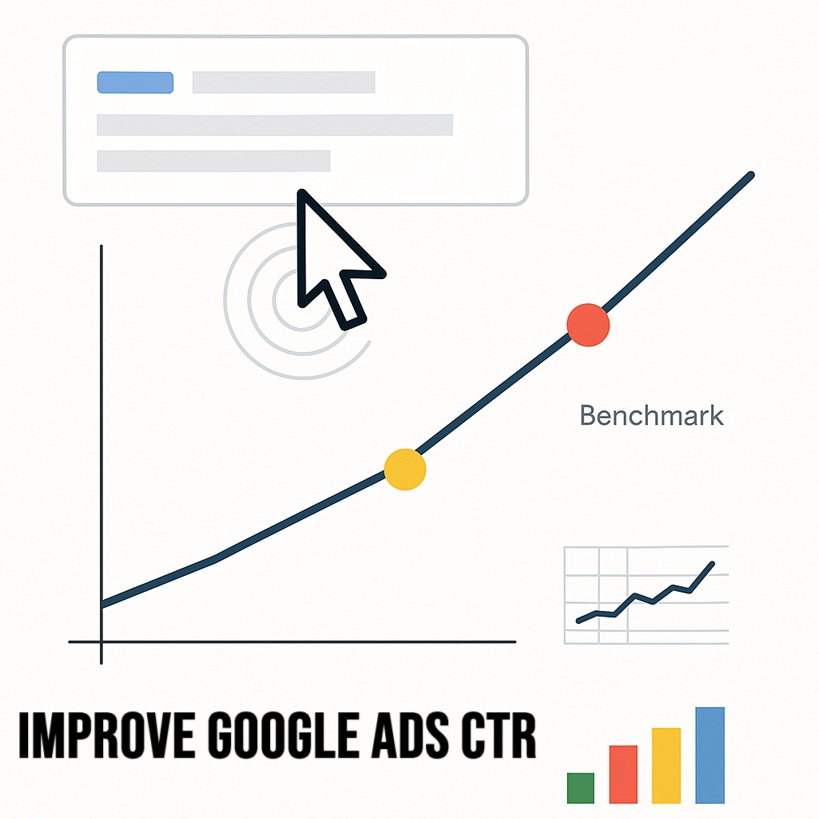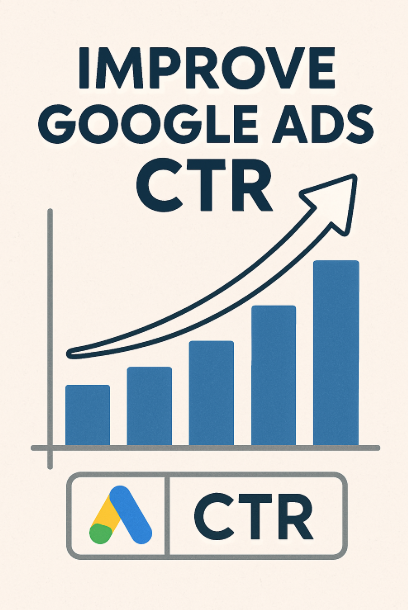Top Strategies to Improve Google Ads Click-Through Rate
Do you need more clicks on your Google Ads? Improving your Google Ads click-through rate (CTR) can significantly boost performance and make your budget more efficient. In this article, we will share actionable strategies for improving your CTR.
Key Takeaways
- A high click-through rate (CTR) is crucial for ad performance and can increase views, sales, and profits.
- Focusing on Quality Score and using relevant keywords helps improve ad relevance and ultimately boosts CTR.
- Crafting compelling ad copy and utilizing strong calls-to-action significantly enhances user engagement and click-through rates.

Understanding Click-Through Rate (CTR) in Google Ads
Click-through rate (CTR) is a fundamental metric in the world of Google Ads. It represents the percentage of user impressions that result in a click on an ad. The average ctr is calculated straightforwardly: divide the number of clicks by the number of impressions and multiply by 100. For instance, if your ad receives 50 clicks out of 1,000 impressions, your CTR would be 5%.

Start by listing some examples of forbidden forms of the keyword “examples” according to the rule 5. Then, find out if there’s a chance to incorporate the keyword without making any extra assumptions, according to the rule 2. Keep it short.
Why is CTR so important? First, it serves as a gauge of ad performance. A high CTR indicates that your ads are resonating with users and prompting them to click. On the other hand, a low CTR suggests that your ads might not be relevant or appealing, which can lead to wasted time, money, and effort. Constantly working on improving your CTR is crucial because it leads to more views, sales, and profits.
CTR is important for several reasons:
- It serves as a gauge of ad performance.
- A high CTR indicates that your ads are resonating with users and prompting them to click.
- A low CTR suggests that your ads might not be relevant or appealing, which can lead to wasted time, money, and effort.
- The higher your ctr, constantly working on improving your CTRs is crucial because it leads to more views, sales, and profits.
The average click-through rate for Google search ads is approximately 6.11%. This figure reflects typical performance in digital advertising. However, what constitutes a good CTR can vary by industry, with some benchmarks ranging from 2% to 6%. Achieving a high CTR not only improves your ad performance but also enhances your ad rank, making your ads more likely to appear at the top of search results. The expected click through rate for google ads can significantly influence these outcomes.

Importance of Quality Score for CTR
Quality Score is a diagnostic tool that Google Ads uses to measure the quality of your ads compared to other advertisers. It is scored on a scale from 1 to 10 and is influenced by three main components: expected clickthrough rate, ad relevance, and landing page experience. A higher Quality Score typically results in more effective and relevant ads, which in turn can improve your CTR.
Why does Quality Score matter? Well, ads with higher Quality Scores generally incur lower costs per click, making your advertising budget stretch further. Additionally, ad extensions can improve your Quality Score by making your ads more informative and engaging.
Focusing on Quality Score helps achieve better ad rank, lower costs, and higher click-through rates.
Keyword Strategies to Boost CTR
Choosing the right keywords is essential for boosting your Google Ads CTR. Bidding on the wrong keywords can significantly lower your click-through rates, wasting your budget on users who aren’t interested in your product or service. Therefore, implementing effective keyword strategies is crucial to improve CTR in Google Ads.
Reevaluating and adjusting keywords ensure your ads reach the right audience, leading to higher CTR. Additionally, adding ad extensions can make your ads more visually appealing, helping them stand out from competitors.
Target Relevant Keywords
Targeting relevant keywords is one of the most effective ways to improve your Google Ads CTR. Incorporating relevant keywords within your ad’s headline and copy is essential for catching the attention of users. Ads that feature relevant keywords tend to receive significantly more clicks compared to generic ads.
Focusing on low-to-medium competitive keywords can also improve your CTR, as these keywords are often less costly and more targeted. By using relevant keywords, you can effectively reach your target audience and enhance your ad performance, ultimately influencing the keyword’s expected ctr.
Use Negative Keywords Effectively
Negative keywords are search terms that prevent your ads from showing for irrelevant queries. Implementing negative keywords can help refine your audience targeting, ensuring that your ads only appear for searches that are relevant to your product or service.
Negative keywords ensure your ads appear only for relevant searches, optimizing your ad spend and enhancing your click-through rate. This ensures your budget is spent on clicks likely to convert, improving campaign performance.
Crafting Compelling Ad Copy
Compelling higher converting ad copy significantly enhances your Google Ads CTR. Stronger, more engaging ads are more likely to attract clicks. Your ad copy should provide solid information about why users should choose your company, making it clear what sets you apart from competitors.

An engaging and relevant headline often forms the initial impression of an ad. Including your main keyword in the display path can also indicate value or reassure viewers. Additionally, using subtle language in emotional ads helps create a better connection with users.
Write Clear and Engaging Headlines
Effective ad headlines boost CTR considerably. For example, headlines like ‘$79 bridesmaid dresses’ are clear, engaging, and directly convey value. Numbers in headlines can dramatically enhance click-through rates, with some reports indicating a high click through rate of 200% increase.
Special deals or promotions in headlines can drive more clicks. Keep your language simple and avoid lengthy text to make your headlines easier to read and understand. Lastly, adding a strong call-to-action in your ad copy encourages user engagement and action.
Include a Strong Call-to-Action (CTA)
Compelling CTAs motivate users to take immediate actions such as purchasing or signing up. A well-crafted CTA convinces users of the following steps to take in response to your ad.
Phrases like ‘Sign Up Today’, ‘Get Your Free Trial’, or ‘Shop Now’ are strong CTAs that prompt user interaction. Incorporating strong CTAs in your ads can significantly boost user engagement and improve your click-through rates.
Highlight Special Offers
Limited-time offers in ad copy capture user interest and drive higher engagement rates. Phrases such as ‘limited-time offer’ or ‘exclusive deal’ in headlines create urgency and attract clicks, especially when comparing two ads.

Overall, implementing special offers in your ad copy leads to improved click-through rates, making your campaigns more effective. Prominently highlighting these offers convinces users to click on your ad and take action.
Optimizing Ad Assets
Ad assets, formerly ad extensions, are a powerful tool in Google Ads that can significantly enhance your ad’s performance. They increase ad size and relevance, helping your ads stand out in search results. Implementing ad extensions can lead to higher user interaction and increased click rates due to the additional valuable information they provide.
There are various types of ad extensions, including location, call, and sitelink extensions, each serving different purposes. For example, adding phone numbers and customer reviews through ad extensions can almost double the size of an advertisement, making it more engaging and informative.
Improving Ad Relevance
Enhancing ad relevance is crucial for boosting your Google Ads CTR. The relevance of keywords, ads, and listings to one another can significantly impact the CTR. Using commercial intent keywords can enhance CTR as these indicate a user’s readiness to purchase.
Ad extensions can also enhance the relevance of ads, allowing them to align better with users’ search queries. Moreover, the relevance of landing pages to the user’s intent is crucial for positive ad performance, particularly in terms of ad relevance users.
Align Ads with User Intent
Understanding user intent helps in designing ad campaigns that resonate more effectively with target audiences. Your ads should be crafted to directly address the specific goals or needs that users click have when they search network user’s search.
Aligning ad language with user search terms boosts ad campaign effectiveness. These strategies lead to improved engagement rates as your ads align more closely with user needs.
Use Dynamic Keyword Insertion
Dynamic keyword insertion allows for personalized ad messages, enhancing alignment with varying user searches. This feature can significantly improve ad relevance by matching the query terms directly in the ad text, which can also affect the ad position. This makes your ads appear more relevant to users, increasing the likelihood of clicks.
Testing and Refining Your Ads
Regularly testing and refining your ads is essential for optimizing their performance. Evaluating ad performance identifies areas needing improvement, ensuring ad effectiveness. Tools that automate data tracking streamline monitoring and provide timely insights.
Ongoing testing of different ad formats and ad copies can lead to better engagement rates. By continually refining your ads, you can discover what elements resonate most with your audience and make data-driven decisions to improve your CTR.
Conduct A/B Testing
A/B testing is a valuable method for identifying which ad copy converts better, helping to improve ad performance. In A/B testing, two versions of an ad are shown to the audience to determine which yields better results.
This testing can involve experimenting with ad components like headlines or calls to action to discover what engages users most. Setting a clear goal before testing helps measure the success of different ad versions effectively.
Pause Underperforming Ads
Pausing underperforming ads optimizes your advertising budget. Identify underperforming ads by monitoring their click-through rates against your benchmarks.
Utilizing Google Ads’ reporting tools can help analyze performance data over time and identify ads with consistently low CTR and ad ranks. Reallocating budget from underperforming ads to successful google ads campaigns can improve google ads ctr and enhance overall campaign effectiveness.
Enhancing Landing Pages
Linking ads to relevant landing pages can significantly boost your CTR and improve click through rate conversion rates. High-quality, relevant landing pages directly influence a good click through rate and click-through rates.
High-quality landing pages can lead to lower costs per click and higher conversion rates. Linking ads to specific site sections ensures users find the exact products they seek, improving their experience.
Leveraging Audience Targeting
Google Ads allows advertisers to utilize audience segments based on demographics, interests, and behaviors to improve ad targeting. Custom segments allow advertisers to precisely define their audience using specific keywords, URLs, and apps relevant to their products, including a generic ad group tailored to their needs and relevant ad groups within their google ads account.
These strategies narrow the target audience, ensuring your ads reach users most likely to click. This targeted approach can lead to higher click-through rates and better campaign performance overall, helping to target visitors effectively and reach your target market.
Monitoring and Adjusting Campaigns
Understanding CTR can help identify both successful and underperforming ads within a campaign. By regularly monitoring competitor performance, you can gain valuable insights into optimizing your own campaigns. Adjusting bids and targeting based on performance data enhances ad visibility and improves click-through rates. Additionally, ctr helps determine the effectiveness of your strategies.
Regularly reviewing and pausing ads that do not meet performance benchmarks helps in reallocating budget to more effective campaigns. Testing ad variations is essential for optimizing performance and making data-driven decisions.
Summary
Boosting your Google Ads click-through rate involves a multifaceted approach that includes understanding CTR, improving Quality Score, targeting relevant keywords, crafting compelling ad copy, optimizing ad extensions, improving ad relevance, testing and refining ads, enhancing landing pages, leveraging audience targeting, and continuously monitoring and adjusting campaigns. By implementing these strategies, you’ll be well on your way to achieving higher CTRs, better ad performance, and ultimately, greater success in your advertising efforts. Remember, the key to success lies in constant evaluation and improvement. Happy advertising!
Frequently Asked Questions
What is CTR and why is it important?
CTR, or Click-Through Rate, measures how often users click on an ad after seeing it. It is crucial for understanding how well your ads perform in drawing interest. A higher CTR can lead to more views, sales, and, ultimately, greater profits for your business.
How does Quality Score affect CTR?
A higher Quality Score leads to more relevant ads, significantly boosting your CTR. So, focusing on improving your Quality Score can really pay off!
What are negative keywords and how do they help?
Negative keywords are essential for ensuring your ads don’t show up in irrelevant searches, saving you money and improving your targeting. By filtering out those less likely to engage, you can focus your budget on reaching the right audience.
Why is ad copy important for improving CTR?
Ad copy is key to boosting CTR because captivating headlines and engaging content draw people’s attention and make them more likely to click. When your ad speaks directly to the audience’s interests, the chances of them engaging with it significantly increase.
How can I use audience targeting to improve my Google Ads CTR?
Using audience targeting in Google Ads can significantly boost your CTR by ensuring your ads reach the right people based on their demographics, interests, and behaviors. You’ll see more clicks and better results by focusing your efforts on those most likely to engage.

